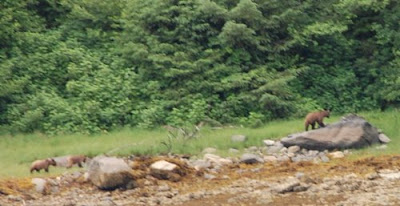The next year we watched “Clam Digger” digging his way along the beach. He was huge, cracking the shells by banging them on his thigh. Another year we saw a mother and cub and wondered if it was Miss Silver grown up. The cub was learning how to dig for food, but mostly played and napped while his mother dug her long trench along the beach.
Once with son Cosmo we came upon a young bear swimming, who then climbed up on a log and made its way into the forest where another bear was looking out from the trees. We called him “Cosmo’s Bear,” and thought we saw him again the following summer, recognizing the blondish stripe.
We always carefully scan the beach and green areas as soon as we pass the waterfall near the end of Quattoon Inlet. After we anchor at the edge of the estuary, as soon as the tide is high enough, we take the dinghy up the Toon River. Here are some of our Toon River neighbours.

It is a wonderful experience taking a respectful peek at this grizzly home. Whether or not we see any animals, it is a glimpse of the drama of another species’ way of life. (I remember cousin Bill saying: “I don’t have to see a grizzly. Just to be where they are, to know they are there, is wonderful!”)

In the evening we saw this young grizzly on the smaller beach beside our anchoring spot. He kept looking over his shoulder at something we couldn’t see on the main estuary. “What’s he worried about?” we wondered. We called him Winnie, short for “Wee Winnie,” and enjoyed his presence beside us.


Next morning Thomas was about to pull the anchor in order to catch the current back out the inlet. He hadn’t seen any creatures stirring. One more scan of the tall grasses behind the main beach and there was a bear. Look again and there were two of them!

 The darker grizzly is male - see the large hump on his shoulders
The darker grizzly is male - see the large hump on his shouldersThen Winnie showed up back in his spot of the night before.

Here Winnie is approaching the large male, staying well off the yellow seaweed between them.

The adult pair leave the sedges in the grasslands and walk over to Winnie’s beach.
We said goodbye to Winnie as he headed for the sedges behind the big beach

Leaving Quattoon Inlet and back into Work Channel, we saw this grizzly mother and two cubs near the Ensheshese River estuary in Graves Bay.

Often a grizzly mother protects her cubs by keeping away from the main grizzly habitat. (Last year, with son Will, Anna and crew, we met a mother and very young cub on an island, a quite unusual occurance--probably chased there by a male bear.) This mother wanted her cubs away from our boat.
Goodbye and thank you to six wonderous grizzlies that live in the rich abundance of the Tsimpsean Peninsula. May it always be so!



















No comments:
Post a Comment